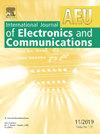Measurement and analysis of lamination effects on a compact dual-band bandstop filter for wireless applications
IF 3.2
3区 计算机科学
Q2 ENGINEERING, ELECTRICAL & ELECTRONIC
Aeu-International Journal of Electronics and Communications
Pub Date : 2025-07-11
DOI:10.1016/j.aeue.2025.155942
引用次数: 0
Abstract
A compact dual-band bandstop filter (DBBSF) incorporating a transversal filtering section based on parallel coupled lines is designed to achieve high selectivity and precise RF performance. The proposed filter employs a novel topology combining shunt- and series-connected coupled lines, generating seven transmission poles and four transmission zeros to effectively suppress undesired frequency bands. The DBBSF is implemented on two substrates, Rogers AD250C, and Teslin SP1400, using the Ansys HFSS full-wave simulator. For the first time, the Teslin-based filter is laminated to enhance durability. The filter measurements with and without lamination are performed to evaluate the effects of parameters, including insertion loss, return loss, centre frequencies, and fractional bandwidth. Measured stopband frequencies are centred at approximately 1.1 GHz and 2.4 GHz, with fractional bandwidths of 29.5 % and 14.5 %, respectively. The measured parameters provide considerable insights into the design of laminated RF components, enabling optimized performance for wireless communication systems and related measurement applications.
无线应用的紧凑型双频带阻滤波器层压效应的测量与分析
设计了一种紧凑的双带阻滤波器(DBBSF),该滤波器采用基于平行耦合线的横向滤波部分,以实现高选择性和精确的射频性能。该滤波器采用一种新颖的拓扑结构,结合并联和串联耦合线,产生7个传输极点和4个传输零点,以有效抑制不需要的频段。dbsf采用Ansys HFSS全波模拟器在Rogers AD250C和Teslin SP1400两个基板上实现。第一次,基于teslin的过滤器是层压的,以提高耐用性。进行了有和没有层压的滤波器测量,以评估参数的影响,包括插入损耗、回波损耗、中心频率和分数带宽。测量的阻带频率集中在大约1.1 GHz和2.4 GHz,分数带宽分别为29.5%和14.5%。测量参数为层压RF组件的设计提供了重要的见解,从而优化了无线通信系统和相关测量应用的性能。
本文章由计算机程序翻译,如有差异,请以英文原文为准。
求助全文
约1分钟内获得全文
求助全文
来源期刊
CiteScore
6.90
自引率
18.80%
发文量
292
审稿时长
4.9 months
期刊介绍:
AEÜ is an international scientific journal which publishes both original works and invited tutorials. The journal''s scope covers all aspects of theory and design of circuits, systems and devices for electronics, signal processing, and communication, including:
signal and system theory, digital signal processing
network theory and circuit design
information theory, communication theory and techniques, modulation, source and channel coding
switching theory and techniques, communication protocols
optical communications
microwave theory and techniques, radar, sonar
antennas, wave propagation
AEÜ publishes full papers and letters with very short turn around time but a high standard review process. Review cycles are typically finished within twelve weeks by application of modern electronic communication facilities.

 求助内容:
求助内容: 应助结果提醒方式:
应助结果提醒方式:


